All 5 books below will be delivered as 2 files for $20. Your download will be delivered by Ravelry

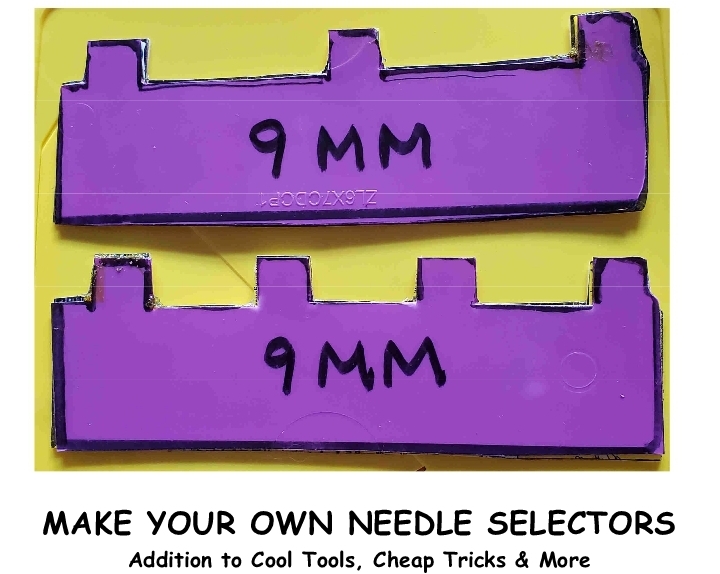 |
This is the most recent addition to the Cool Tools, Cheap Tricks & More collection. It is a separate file. Be sure to download it along with the other when you make your purchase. |
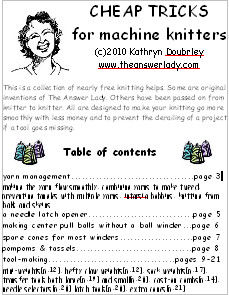 This is a collection of nearly free knitting helps. Some are original inventions of The Answer Lady. Others have been passed on from knitter to knitter. All are designed to make your knitting go more smoothly with less money and to prevent the derailing of a project if a tool goes missing. I am especially pleased to be able to offer the tool-making section. It includes ways to make all the tools machine knitters regularly use plus some extras. 21 fully illustrated pages.
This is a collection of nearly free knitting helps. Some are original inventions of The Answer Lady. Others have been passed on from knitter to knitter. All are designed to make your knitting go more smoothly with less money and to prevent the derailing of a project if a tool goes missing. I am especially pleased to be able to offer the tool-making section. It includes ways to make all the tools machine knitters regularly use plus some extras. 21 fully illustrated pages.contents: Yarn management,making the yarn flow smoothly, combining yarns to make tweed, preventing tangles, intarsia bobbins, knitting from balls and skeins, latch opener, center pull balls without a winder, spare cones for most winders, pompoms, tassels, tool-making, weights of all sizes, cast on combs, latch tools, needles selectors |
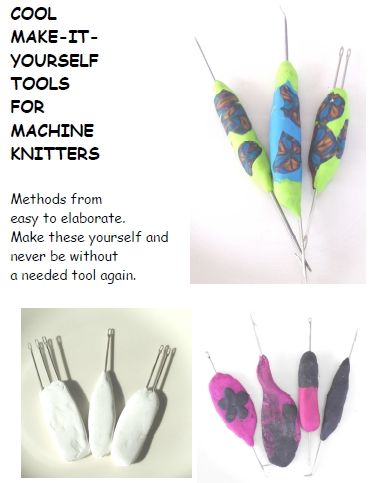 TABLE OF CONTENTS
TABLE OF CONTENTSList of supplies………..page 3 Safety notes…………...page 5 Basic process…………..page 6 Sizing…………………………page 6 Positioning………………..page 7 Shaping handles……..page 10 Basic baked clay…...page 12 Pitfalls…………………….page 13 Fancy baked clay…..page 14 Clay coins………………..page 15 Handle making process....16 Individual tool instructions……pages 17-23 Review…………………….page 24 Tool making log…… .page 25 Tools for any gauge or brand of machine may be made using the methods in this book. The materials required are readily available from knitting machine suppliers and craft stores. The process is simple, quite fast and the results are just as good as purchased tools. |
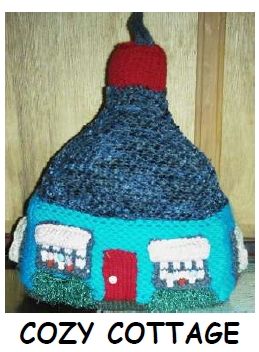 This tea cozy measures 10”X6” and will accommodate a standard 1 quart
This tea cozy measures 10”X6” and will accommodate a standard 1 quartteapot including the handle and spout. The roof is stuffed with fiberfill to give it shape and extra insulation. The sides are reinforced with craft foam for the same reasons. The piece is a sampler of many stitches and techniques, making it a good practice piece. The weaving, tuck and slip stitch all use the same punchcard. It also makes an excellent gift. Any bulky machine can make this including Bonds and other hobby machines. Help notes for hobby machines are included. If your mid-gauge knits worsted weight yarn comfortably, it may be used as well but do remember that there is weaving and tucking in use so if stockinette requires the largest stitch size and knits stiffly, most likely weaving and tuck will be problematic. 7 pages |
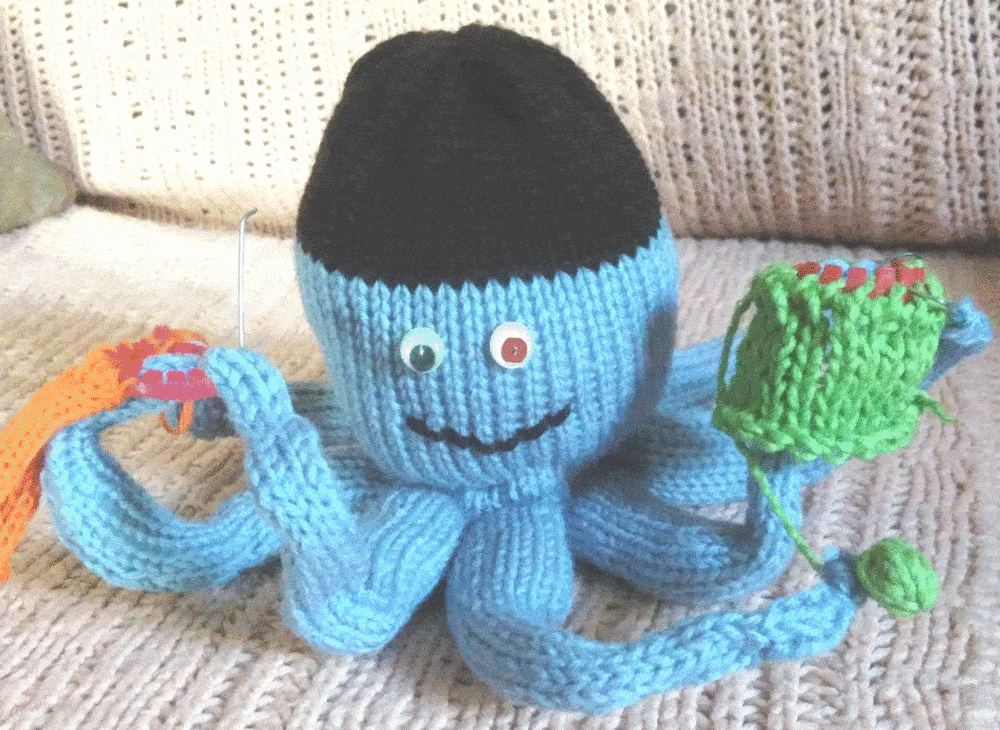 BUSY OCTOPUS
What is he busy doing? Anything you want. The sample is loom knitting but take a trip to the dollar store and look around. Yours could be babysitting, playing musical instruments, picking flowers, cooking and the list goes on.
BUSY OCTOPUS
What is he busy doing? Anything you want. The sample is loom knitting but take a trip to the dollar store and look around. Yours could be babysitting, playing musical instruments, picking flowers, cooking and the list goes on. YARN, GAUGE, SIZE AND MACHINE Any machine may be used. The octopus shown is knitted flat. However, those with two beds could knit him in the round so instructions for that are included. Two gauges are given. The bulkier one, using Mary Lue’s Liberty Plus or a similar worsted weight yarn at stitch size 3 works on bulky and mid-gauge machines. An option using fingering to sport weight yarn will work for standard, Passap and Superba machines. Gauge is 4.5 stitches/ 6 rows/” for the worsted weight version, 7 stitches/10 rows/” for the fingering-sport version. For this pattern, matching gauge is not at all critical. Feel free to substitute yarns. Adjust for a firm fabric so that the knitting will hold the stuffing in nicely. The bulky version is given first with the numbers that apply to the standard version in parentheses. If gauge is matched perfectly, tentacle is about 7” long. The octopus sits about 5” tall. 4 ounces or less of yarn required. |
I do a lot of teaching of a lot of needle arts. The following thoughts have been bubbling around in my mind for some time. Here's a little essay on teaching and learning the domestic arts:
If you took home economics during the 1940s-1970s, you may have shared my experience. My home ec teacher was Mrs M. [M is for Meanie and not her real name, nor is she still living. I would not embarrass her, though she felt no such reluctance]. Her standards were exacting. She seemed to feel that she had been given divine information about the correct way to insert a pin into fabric and many other matters. Anything other than perfection invited her scorn. Scorn and public humiliation were her primary teaching tools. And lest you think I was suffering from adolescent exaggeration, here is an example: on one occasion she berated me at length for stapling the corner of my test papers together in a manner that she disapproved.
Unfortunately, many of our mothers subscribed to the same teaching methods regarding the domestic arts. The result is that several generations of women who detest them and would rather do practically anything than try to knit, sew, cook or crochet and who get nauseous just thinking about it. I spent some years being mad at Mrs. M and her sisters of scorn but I finally realized that they were only doing what they thought was the right thing. They were simply mistaken.
Happily for me, I had grandmothers and a 4H leader with gentler, more encouraging teaching styles and they got to me before Mrs. M. did. So in my case, she gave me a bad couple of years but failed to sour me on needlework.
In the many, many years since, I have taught a great many girls and women sewing, knitting and other needle arts and I have learned a few things about teaching that I think are worth passing on.
The main thing I have learned is that nobody can learn when she is desperately afraid of failing or making a fool of herself. The brain just shuts off as a matter of self preservation. There is enough unfortunate residue of that old punitive teaching style wandering around in the culture that the teacher must actively overcome it.
I have found that most students give something a cursory try and, not being skilled, make an inexpert attempt at which point they are ready to cry "I can't do it...I am not talented...I don't like it!" to which we, as teachers need to reply, "You CAN do it, you have not yet had time to discover your talent and that of course you don't like it YET but you will when you gain some skill--and you will."
We live in a time when advertising has attempted to convince us that if we plunk down our money, we can be instantly successful at whatever is for sale. It is not so, has never been so and cannot be so. People need practice. No valuable skill is ever gained without some messy, imperfect attempts. But it is OK to waste a bit of yarn, fabric and so on in the pursuit of learning. The time you spend is not wasted, it is invested.
I do believe in the value of excellence. But I also know that it cannot be achieved instantly. It works very well to help a student celebrate every improvement. It is fine that she realize the work is not yet perfect but she should also note ways in which it is better than her last try. Small victories get us down the road.
So, if you are a teacher, please be patient with your student but don't allow her to give up in despair. Re-state the instructions gently as many times as necessary. Look at the work from many angles. Help her see the signs of progress as they appear. And if you are a student, also be patient with yourself and don't give up in despair. The truth is that every normal person and quite a lot of people with significant disabilities can become really excellent at needle arts. And if they are presently giving you a literal pain in the neck, realize that as you relax and gain skill, that will go away. A wonderful sense of peaceful relaxation will slowly take the place of the tension. Encourage that. Work in short spells and then rest. And remember, perfect stitches are not a moral issue. Be happy.Website hosting and domain registration powered by DomainNameSanity.com
download instructions for creating an extended Bond machine
download instructions for a DIY cast on comb
If you took home economics during the 1940s-1970s, you may have shared my experience. My home ec teacher was Mrs M. [M is for Meanie and not her real name, nor is she still living. I would not embarrass her, though she felt no such reluctance]. Her standards were exacting. She seemed to feel that she had been given divine information about the correct way to insert a pin into fabric and many other matters. Anything other than perfection invited her scorn. Scorn and public humiliation were her primary teaching tools. And lest you think I was suffering from adolescent exaggeration, here is an example: on one occasion she berated me at length for stapling the corner of my test papers together in a manner that she disapproved.
Unfortunately, many of our mothers subscribed to the same teaching methods regarding the domestic arts. The result is that several generations of women who detest them and would rather do practically anything than try to knit, sew, cook or crochet and who get nauseous just thinking about it. I spent some years being mad at Mrs. M and her sisters of scorn but I finally realized that they were only doing what they thought was the right thing. They were simply mistaken.
Happily for me, I had grandmothers and a 4H leader with gentler, more encouraging teaching styles and they got to me before Mrs. M. did. So in my case, she gave me a bad couple of years but failed to sour me on needlework.
In the many, many years since, I have taught a great many girls and women sewing, knitting and other needle arts and I have learned a few things about teaching that I think are worth passing on.
The main thing I have learned is that nobody can learn when she is desperately afraid of failing or making a fool of herself. The brain just shuts off as a matter of self preservation. There is enough unfortunate residue of that old punitive teaching style wandering around in the culture that the teacher must actively overcome it.
I have found that most students give something a cursory try and, not being skilled, make an inexpert attempt at which point they are ready to cry "I can't do it...I am not talented...I don't like it!" to which we, as teachers need to reply, "You CAN do it, you have not yet had time to discover your talent and that of course you don't like it YET but you will when you gain some skill--and you will."
We live in a time when advertising has attempted to convince us that if we plunk down our money, we can be instantly successful at whatever is for sale. It is not so, has never been so and cannot be so. People need practice. No valuable skill is ever gained without some messy, imperfect attempts. But it is OK to waste a bit of yarn, fabric and so on in the pursuit of learning. The time you spend is not wasted, it is invested.
I do believe in the value of excellence. But I also know that it cannot be achieved instantly. It works very well to help a student celebrate every improvement. It is fine that she realize the work is not yet perfect but she should also note ways in which it is better than her last try. Small victories get us down the road.
So, if you are a teacher, please be patient with your student but don't allow her to give up in despair. Re-state the instructions gently as many times as necessary. Look at the work from many angles. Help her see the signs of progress as they appear. And if you are a student, also be patient with yourself and don't give up in despair. The truth is that every normal person and quite a lot of people with significant disabilities can become really excellent at needle arts. And if they are presently giving you a literal pain in the neck, realize that as you relax and gain skill, that will go away. A wonderful sense of peaceful relaxation will slowly take the place of the tension. Encourage that. Work in short spells and then rest. And remember, perfect stitches are not a moral issue. Be happy.
download instructions for a DIY cast on comb
| Most knitting machines will do the same things but the settings on the carriage are unique to each brand. click here to download a chart that compares the settings for various brands this file is hosted on the free version of mediafire which means that ads will pop up. They are safe--just ads. So ignore them and click only on my file and you will be fine. |
| FREE KNITTING GRAPH PAPER Graph paper that is sized to match a stitch and row gauge exactly is a handy tool and a great "cheap trick". It can be used to chart a sweater design without any math at all. It may also be used to position a motif, experiment with fairisle looks, and chart intarsia patterns. Using such graph paper often advances our ability to visualize sweater parts. To work well, the paper must be very close to representing the true size of a stitch. Here are some common gauges of papers for you to experiment with. The link below will take to to a mediafire download page where you can retrieve them. There is a microsoft .doc version, and Open Office odt. version and an image version. Try to set your printer to print full size without scaling. You may need to adjust the margins to get this. Some printers will automatically get one version just right. Sometimes you have to experiment. Should you come up with tips or other graph papers you are willing to share, please get in touch. We'll expand this file as needed to include as many graph paper helps as we can assemble. Mediafire is a legitimate file-sharing service but its advertising will offer you other things. To be safe, ONLY click on the files you went for. download graph paper |